Tsoulfanidis N. Measurement and detection of radiation
Подождите немного. Документ загружается.

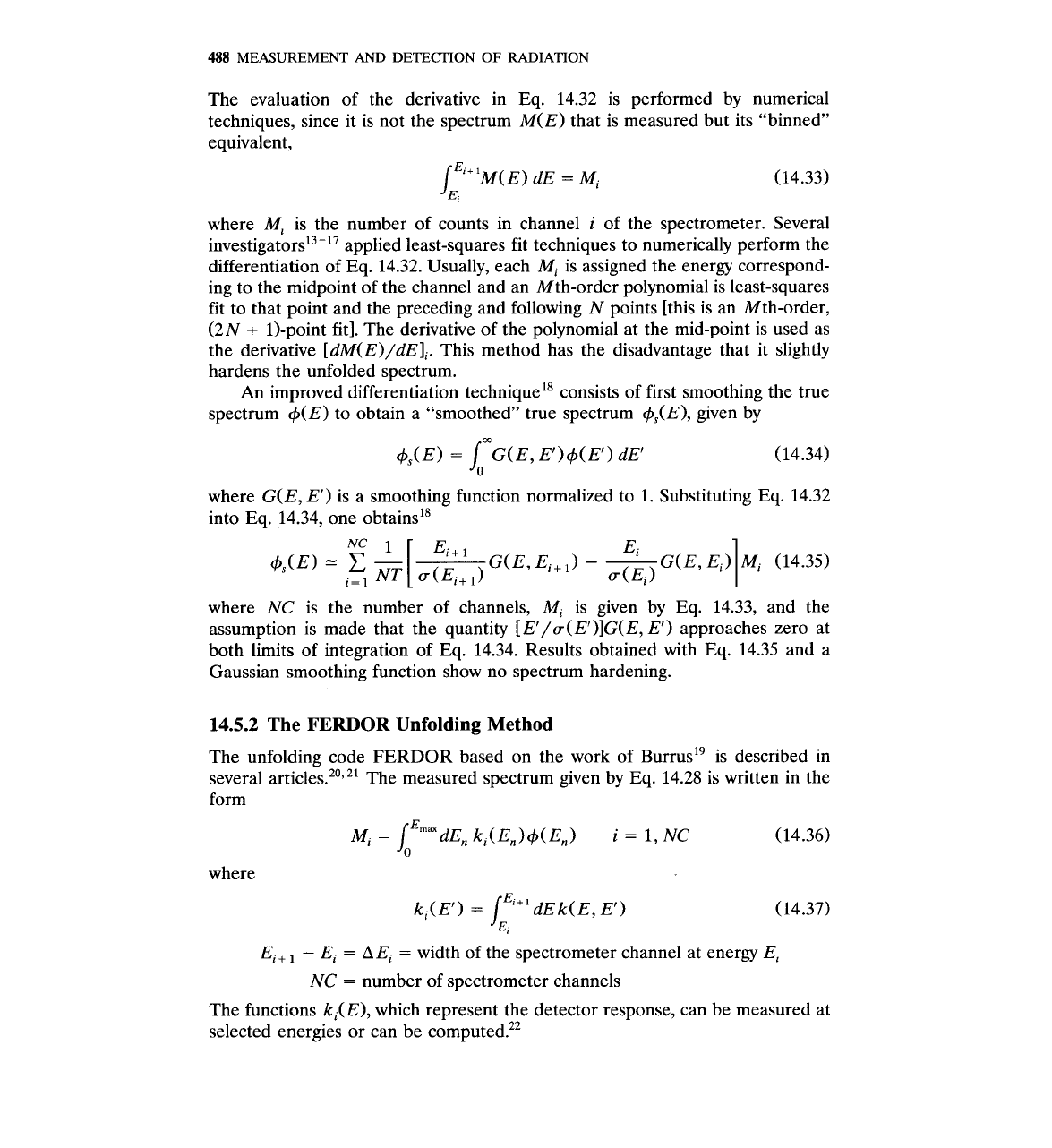
488
MEASUREMENT AND DETECTION
OF
RADIATION
The evaluation of the derivative in Eq. 14.32 is performed by numerical
techniques, since it is not the spectrum M(E) that is measured but its "binned"
equivalent,
I;+'M(E) d~
=
M,
(14.33)
where Mi is the number of counts in channel
i
of the spectrometer. Several
investigator^'^-'^
applied least-squares fit techniques to numerically perform the
differentiation of Eq. 14.32. Usually, each Mi is assigned the energy correspond-
ing to the midpoint of the channel and an Mth-order polynomial is least-squares
fit to that point and the preceding and following
N
points [this is an Mth-order,
(2
N
+
1)-point fit]. The derivative of the polynomial at the mid-point is used as
the derivative [dM(E)/dE],. This method has the disadvantage that it slightly
hardens the unfolded spectrum.
An
improved differentiation technique1' consists of first smoothing the true
spectrum @(E) to obtain a "smoothed" true spectrum
+s(E),
given by
where G(E, E') is a smoothing function normalized to
1.
Substituting Eq. 14.32
into Eq. 14.34, one obtains1'
where
NC
is the number of channels,
Mi is given by
Eq.
14.33, and the
assumption is made that the quantity [E1/a(E')]G(E, E') approaches zero at
both limits of integration of Eq. 14.34. Results obtained with Eq. 14.35 and a
Gaussian smoothing function show no spectrum hardening.
14.5.2
The FERDOR
Unfolding
Method
The unfolding code FERDOR based on the work of ~urrus'~ is described in
several
article^.'^^^^
The measured spectrum given by Eq. 14.28 is written in the
form
where
Ei+
,
-
E,
=
AEi
=
width of the spectrometer channel at energy
Ei
NC
=
number of spectrometer channels
The functions ki(E), which represent the detector response, can be measured at
selected energies or can be
c~mputed.~'
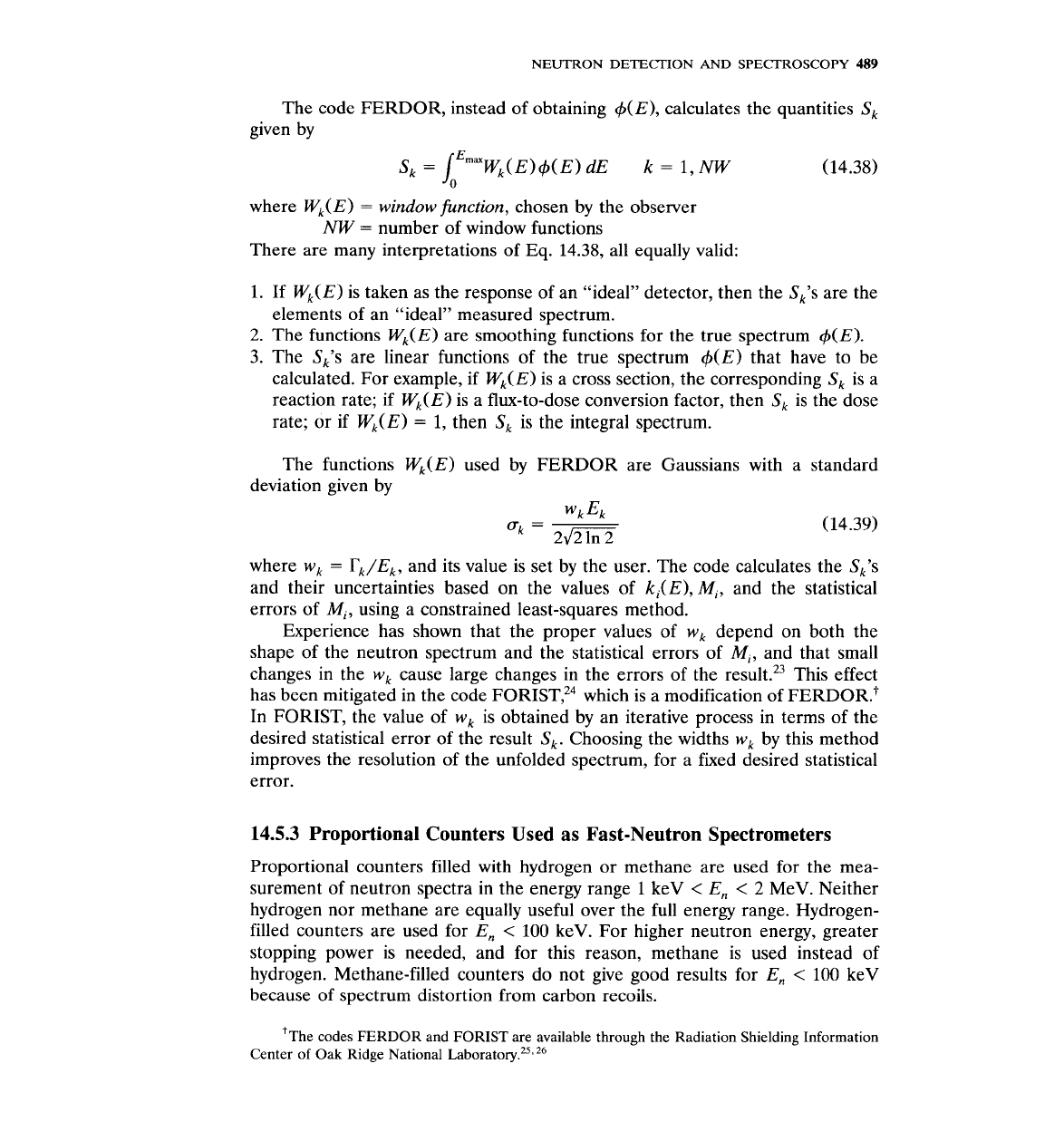
NEUTRON
DETECTION
AND
SPECTROSCOPY
489
The code FERDOR, instead of obtaining +(El, calculates the quantities S,
given by
where W,(E)
=
window function, chosen by the observer
NW
=
number of window functions
There are many interpretations of Eq.
14.38,
all equally valid:
1.
If W,(E) is taken as the response of an "ideal" detector, then the S,'s are the
elements of an "ideal" measured spectrum.
2.
The functions W,(E) are smoothing functions for the true spectrum 4(E).
3.
The Sk7s are linear functions of the true spectrum +(El that have to be
calculated. For example, if W,(E) is a cross section, the corresponding Sk is a
reaction rate; if W,(E) is a flux-to-dose conversion factor, then S, is the dose
rate; or if Wk(E)
=
1,
then S, is the integral spectrum.
The functions Wk(E) used by FERDOR are Gaussians with a standard
deviation given by
where
w,
=
rk/Ek, and its value is set by the user. The code calculates the S,'s
and their uncertainties based on the values of ki(E), Mi, and the statistical
errors of Mi, using a constrained least-squares method.
Experience has shown that the proper values of w, depend on both the
shape of the neutron spectrum and the statistical errors of Mi, and that small
changes in the
w, cause large changes in the errors of the result.23 This effect
has been mitigated in the code
FORIST,~~
which is a modification of FERDOR.~
In FORIST, the value of
w,
is obtained by an iterative process in terms of the
desired statistical error of the result S,. Choosing the widths w, by this method
improves the resolution of the unfolded spectrum, for a fixed desired statistical
error.
14.5.3
Proportional Counters Used as Fast-Neutron Spectrometers
Proportional counters filled with hydrogen or methane are used for the mea-
surement of neutron spectra in the energy range
l
keV
<
En
<
2
MeV. Neither
hydrogen nor methane are equally useful over the full energy range. Hydrogen-
filled counters are used for En
<
100
keV. For higher neutron energy, greater
stopping power is needed, and for this reason, methane is used instead of
hydrogen. Methane-filled counters do not give good results for E,
<
100 keV
because of spectrum distortion from carbon recoils.
t~he codes FERDOR and FORIST are available through the Radiation Shielding Information
Center
of
Oak Ridge National ~aboratory.~~~~~
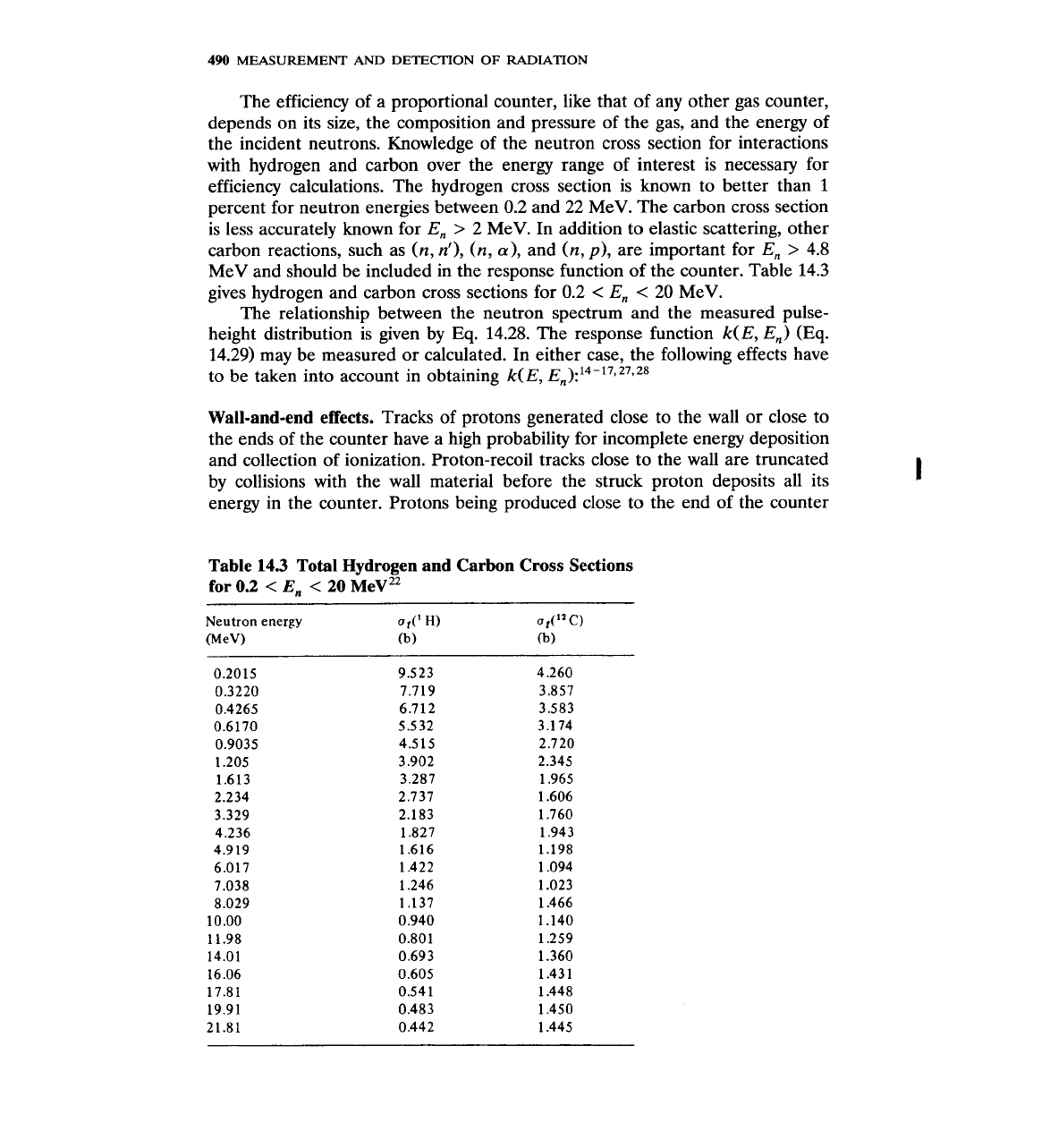
490
MEASUREMENT
AND
DETECTION
OF
RADIATION
The efficiency of a proportional counter, like that of any other gas counter,
depends on its size, the composition and pressure of the gas, and the energy of
the incident neutrons. Knowledge of the neutron cross section for interactions
with hydrogen and carbon over the energy range of interest is necessaq for
efficiency calculations. The hydrogen cross section is known to better than
1
percent for neutron energies between 0.2 and 22 MeV. The carbon cross section
is less accurately known for En
>
2 MeV. In addition to elastic scattering, other
carbon reactions, such as (n, n'), (n,
a),
and (n,
p),
are important for En
>
4.8
MeV and should be included in the response function of the counter. Table 14.3
gives hydrogen and carbon cross sections for 0.2
<
En
<
20 MeV.
The relationship between the neutron spectrum and the measured pulse-
height distribution is given by Eq. 14.28. The response function k(E, En) (Eq.
14.29) may be measured or calculated. In either case, the following effects have
to be taken into account in obtaining
k(E, E~):~~-~~~~~~~~
Wall-and-end effects.
Tracks of protons generated close to the wall or close to
the ends of the counter have a high probability for incomplete energy deposition
and collection of ionization. Proton-recoil tracks close to the wall are truncated
by collisions with the wall material before the struck proton deposits all its
energy in the counter. Protons being produced close to the end of the counter
Table
143
Total Hydrogen and Carbon Cross Sections
for 0.2
<
En
<
20
M~v~'
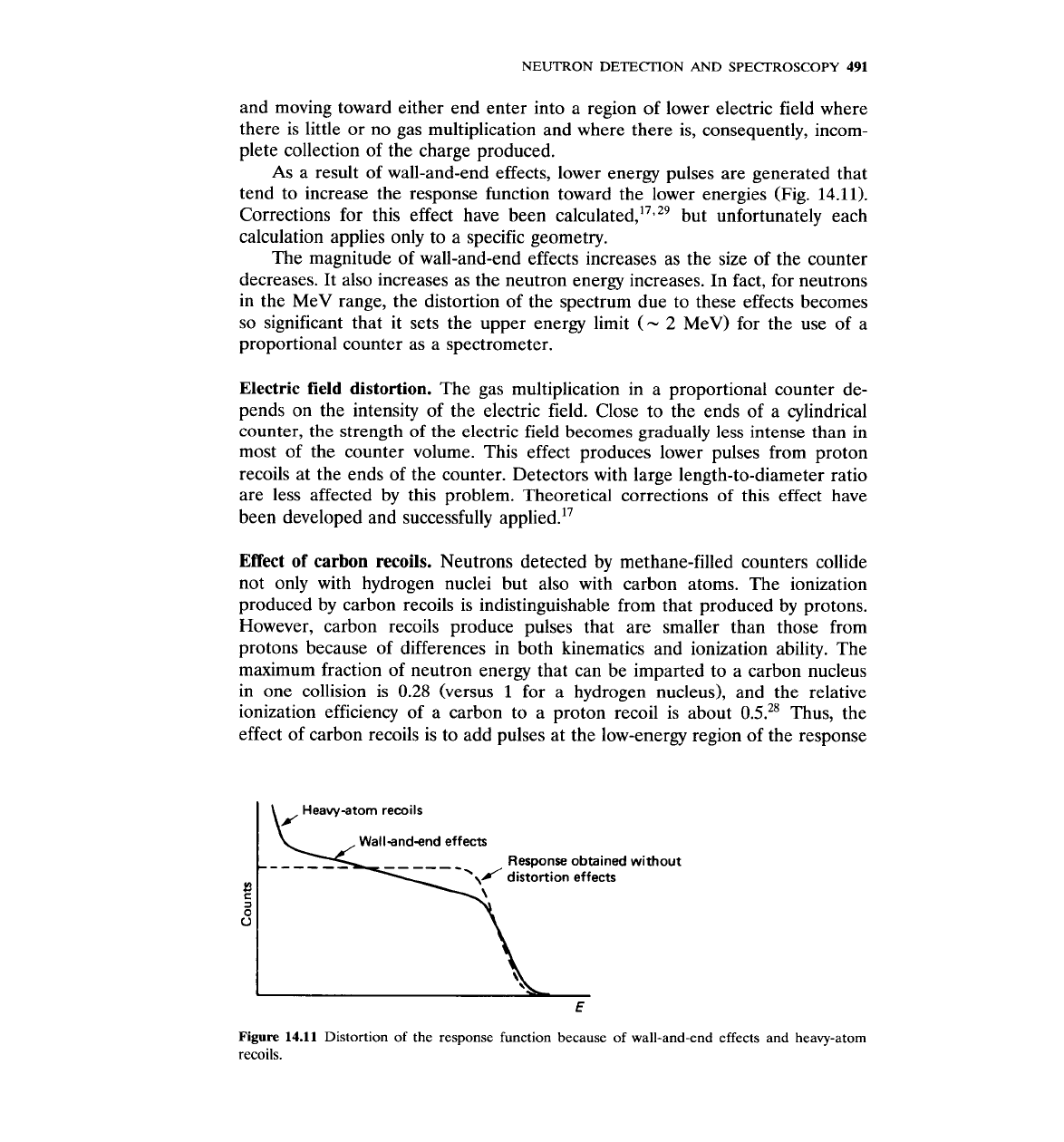
NEUTRON DETECTION
AND
SPECTROSCOPY
491
and moving toward either end enter into a region of lower electric field where
there is little or no gas multiplication and where there is, consequently, incom-
plete collection of the charge produced.
As a result of wall-and-end effects, lower energy pulses are generated that
tend to increase the response function toward the lower energies (Fig. 14.11).
Corrections for this effect have been
~alculated,"~~~ but unfortunately each
calculation applies only to a specific geometry.
The magnitude of wall-and-end effects increases as the size of the counter
decreases. It also increases as the neutron energy increases. In fact, for neutrons
in the MeV range, the distortion of the spectrum due to these effects becomes
so significant that it sets the upper energy limit
(-
2
MeV) for the use of a
proportional counter as a spectrometer.
Electric field distortion.
The gas multiplication in a proportional counter de-
pends on the intensity of the electric field. Close to the ends of a cylindrical
counter, the strength of the electric field becomes gradually less intense than in
most of the counter volume. This effect produces lower pulses from proton
recoils at the ends of the counter. Detectors with large length-to-diameter ratio
are less affected by this problem. Theoretical corrections of this effect have
been developed and successfully
applied.17
Effect of carbon recoils.
Neutrons detected by methane-filled counters collide
not only with hydrogen nuclei but also with carbon atoms. The ionization
produced by carbon recoils is indistinguishable from that produced by protons.
However, carbon recoils produce pulses that are smaller than those from
protons because of differences in both kinematics and ionization ability. The
maximum fraction of neutron energy that can be imparted to a carbon nucleus
in one collision is
0.28
(versus
1
for a hydrogen nucleus), and the relative
ionization efficiency of a carbon to a proton recoil is about 0.5." Thus, the
effect of carbon recoils is to add pulses at the low-energy region of the response
Heavy-atom recoils
Wailandend effects
Response obtained without
E'
8
0
Figure
14.11
Distortion of the response function because of wall-and-end effects and heavy-atom
recoils.
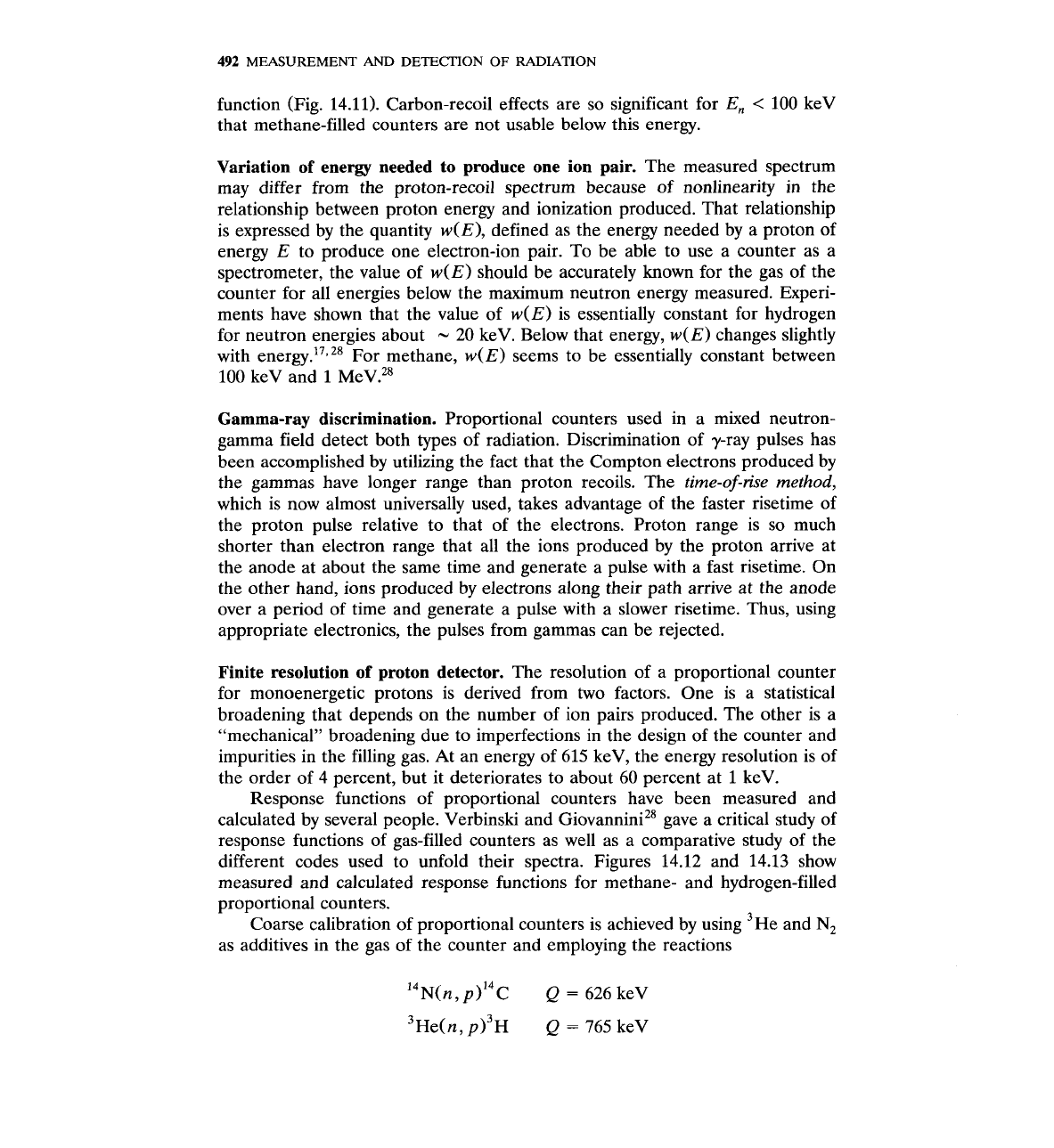
492
MEASUREMENT
AND
DETECTION OF RADIATION
function (Fig. 14.11). Carbon-recoil effects are so significant for En
<
100 keV
that methane-filled counters are not usable below this energy.
Variation of energy needed to produce one ion pair.
The measured spectrum
may differ from the proton-recoil spectrum because of nonlinearity in the
relationship between proton energy and ionization produced. That relationship
is expressed by the quantity w(E), defined as the energy needed by a proton of
energy
E
to produce one electron-ion pair. To be able to use a counter as a
spectrometer, the value of w(E) should be accurately known for the gas of the
counter for all energies below the maximum neutron energy measured. Experi-
ments have shown that the value of w(E) is essentially constant for hydrogen
for neutron energies about
-
20 keV. Below that energy, w(E) changes slightly
with energy.'7'28 For methane, w(E) seems to be essentially constant between
100
keV and
1
M~v.~~
Gamma-ray discrimination.
Proportional counters used in a mixed neutron-
gamma field detect both types of radiation. Discrimination of y-ray pulses has
been accomplished
by
utilizing the fact that the Compton electrons produced by
the gammas have longer range than proton recoils. The
time-of-rise method,
which is now almost universally used, takes advantage of the faster risetime of
the proton pulse relative to that of the electrons. Proton range is so much
shorter than electron range that all the ions produced by the proton arrive at
the anode at about the same time and generate a pulse with a fast risetime. On
the other hand, ions produced by electrons along their path arrive at the anode
over a period of time and generate a pulse with a slower risetime. Thus, using
appropriate electronics, the pulses from gammas can be rejected.
Finite resolution of proton detector.
The resolution of a proportional counter
for monoenergetic protons is derived from two factors. One is a statistical
broadening that depends on the number of ion pairs produced. The other is a
"mechanical" broadening due to imperfections in the design of the counter and
impurities in the filling gas. At an energy of 615 keV, the energy resolution is of
the order of 4 percent, but it deteriorates to about 60 percent at
1
keV.
Response functions of proportional counters have been measured and
calculated by several people. Verbinski and
GiovanniniZ8 gave a critical study of
response functions of gas-filled counters as well as a comparative study of the
different codes used to unfold their spectra. Figures 14.12 and 14.13 show
measured and calculated response functions for methane- and hydrogen-filled
proportional counters.
Coarse calibration of proportional counters is achieved by using
3~e and Nz
as additives in the gas of the counter and employing the reactions
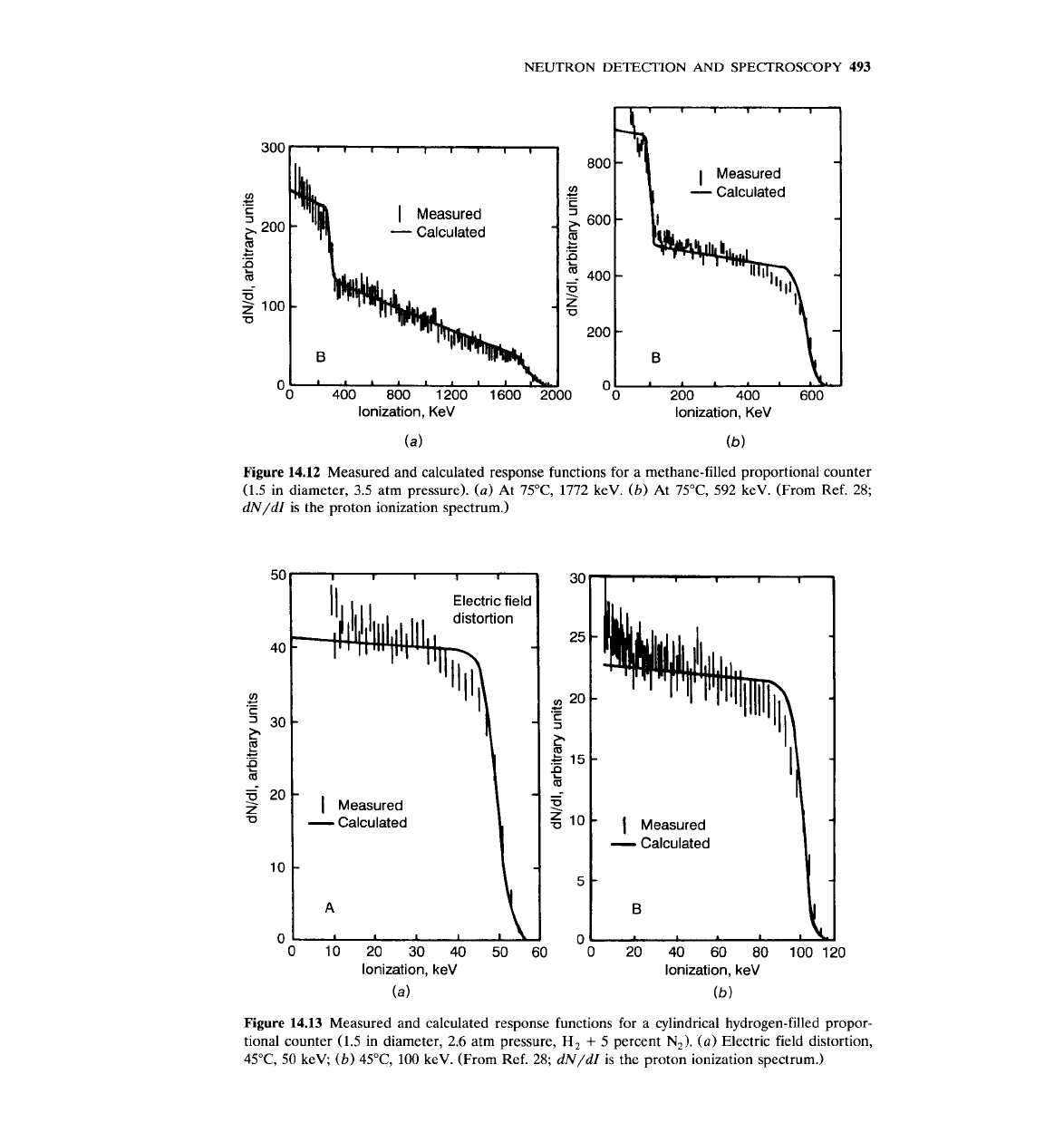
NEUTRON DETECTION
AND
SPECTROSCOPY
493
I
Measured
-
Calculated
lonization, KeV
(a)
800
-
I
Measured
-
Calculated
600
-
I
400
-
200
-
0~"'"'
200 400 600
lonization, KeV
(b)
Figure
14.12
Measured and calculated response functions for a methane-filled proportional counter
(1.5 in diameter,
3.5
atm pressure).
(a)
At 75°C. 1772 keV.
(b)
At 75°C 592 keV. (From Ref. 28;
dN/dI
is the proton ionization spectrum.)
I
Measured
-
Calculated
20 30 40 50
lonization, keV
(a)
-
(
Measured
-
Calculated
B
I
I
20 40 60 80 100 120
lonization, keV
(b)
Figure
14.13
Measured and calculated response functions for a cylindrical hydrogen-filled propor-
tional counter (1.5 in diameter, 2.6 atm pressure,
Hz
+
5 percent
N,).
(a)
Electric field distortion,
45T,
50
keV;
(b)
45T,
100
keV. (From Ref. 28;
dN/dI
is the proton ionization spectrum.)
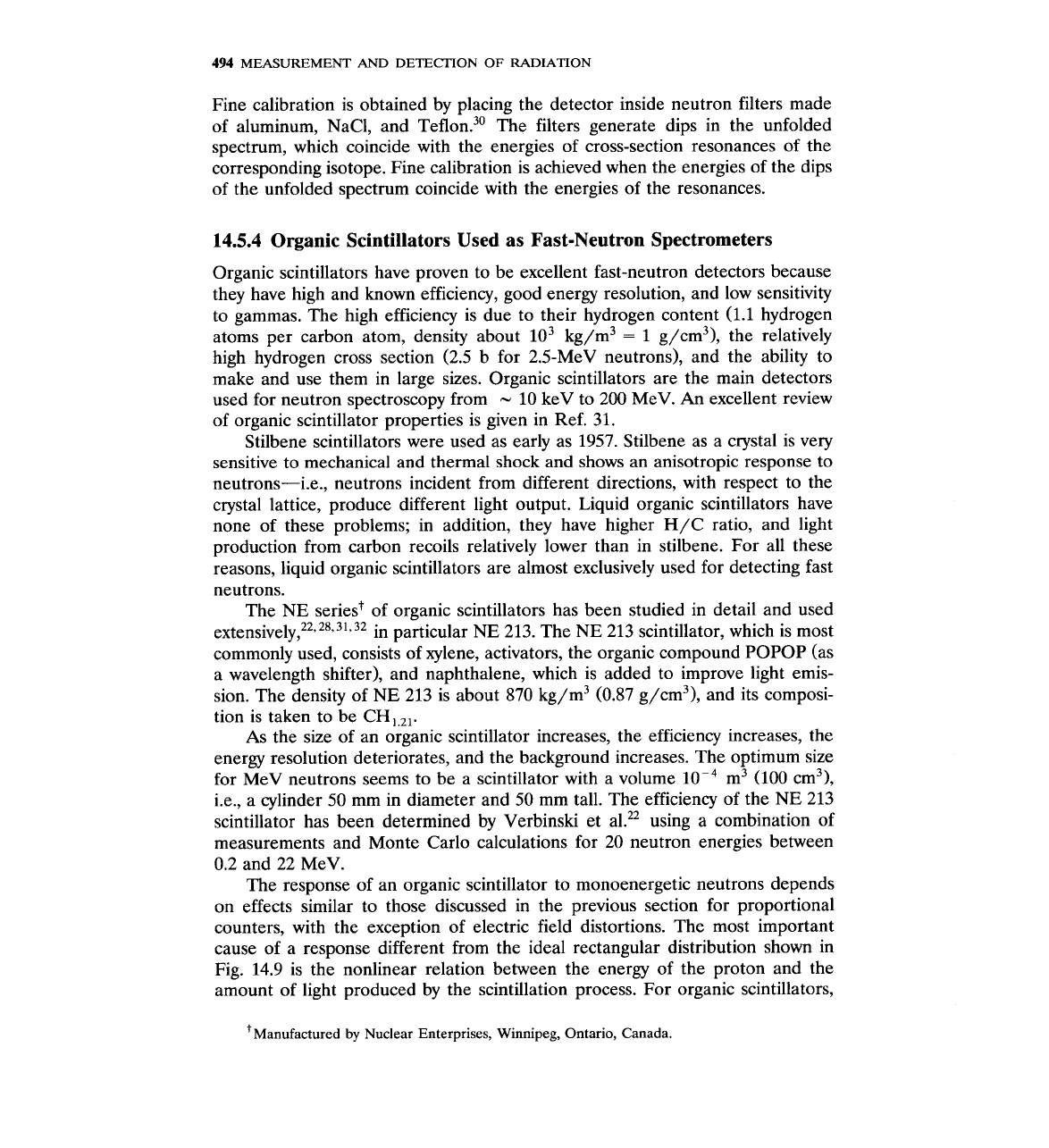
494
MEASUREMENT AND DETECTION OF RADIATION
Fine calibration is obtained by placing the detector inside neutron filters made
of aluminum, NaC1, and ~eflon.~' The filters generate dips in the unfolded
spectrum, which coincide with the energies of cross-section resonances of the
corresponding isotope. Fine calibration is achieved when the energies of the dips
of the unfolded spectrum coincide with the energies of the resonances.
14.5.4
Organic Scintillators Used as Fast-Neutron Spectrometers
Organic scintillators have proven to be excellent fast-neutron detectors because
they have high and known efficiency, good energy resolution, and low sensitivity
to gammas. The high efficiency is due to their hydrogen content (1.1 hydrogen
atoms per carbon atom, density about
lo3
kg/m3
=
1
g/cm3), the relatively
high hydrogen cross section (2.5 b for 2.5-MeV neutrons), and the ability to
make and use them in large sizes. Organic scintillators are the main detectors
used for neutron spectroscopy from
-
10 keV to 200 MeV.
An
excellent review
of organic scintillator properties is given in Ref. 31.
Stilbene scintillators were used as early as 1957. Stilbene as a crystal is very
sensitive to mechanical and thermal shock and shows an anisotropic response to
neutrons-i.e., neutrons incident from different directions, with respect to the
crystal lattice, produce different light output. Liquid organic scintillators have
none of these problems; in addition, they have higher H/C ratio, and light
production from carbon recoils relatively lower than in stilbene. For all these
reasons, liquid organic scintillators are almost exclusively used for detecting fast
neutrons.
The NE seriest of organic scintillators has been studied in detail and used
in particular NE 213. The NE 213 scintillator, which is most
commonly used, consists of xylene, activators, the organic compound
POPOP (as
a wavelength shifter), and naphthalene, which is added to improve light emis-
sion. The density of NE 213 is about 870 kg/m3 (0.87 g/cm3), and its composi-
tion is taken to be CH,,,,.
As the size of an organic scintillator increases, the efficiency increases, the
energy resolution deteriorates, and the background increases. The optimum size
for MeV neutrons seems to be a scintillator with a volume
lop4
m3 (100 cm3),
i.e., a cylinder 50 mm in diameter and 50 mm tall. The efficiency of the NE 213
scintillator has been determined by Verbinski et a1.22 using a combination of
measurements and Monte Carlo calculations for 20 neutron energies between
0.2 and 22 MeV.
The response of an organic scintillator to monoenergetic neutrons depends
on effects similar to those discussed in the previous section for proportional
counters, with the exception of electric field distortions. The most important
cause of a response different from the ideal rectangular distribution shown in
Fig. 14.9 is the nonlinear relation between the energy of the proton and the
amount of light produced by the scintillation process. For organic scintillators,
'Manufactured
by
Nuclear Enterprises, Winnipeg, Ontario, Canada.
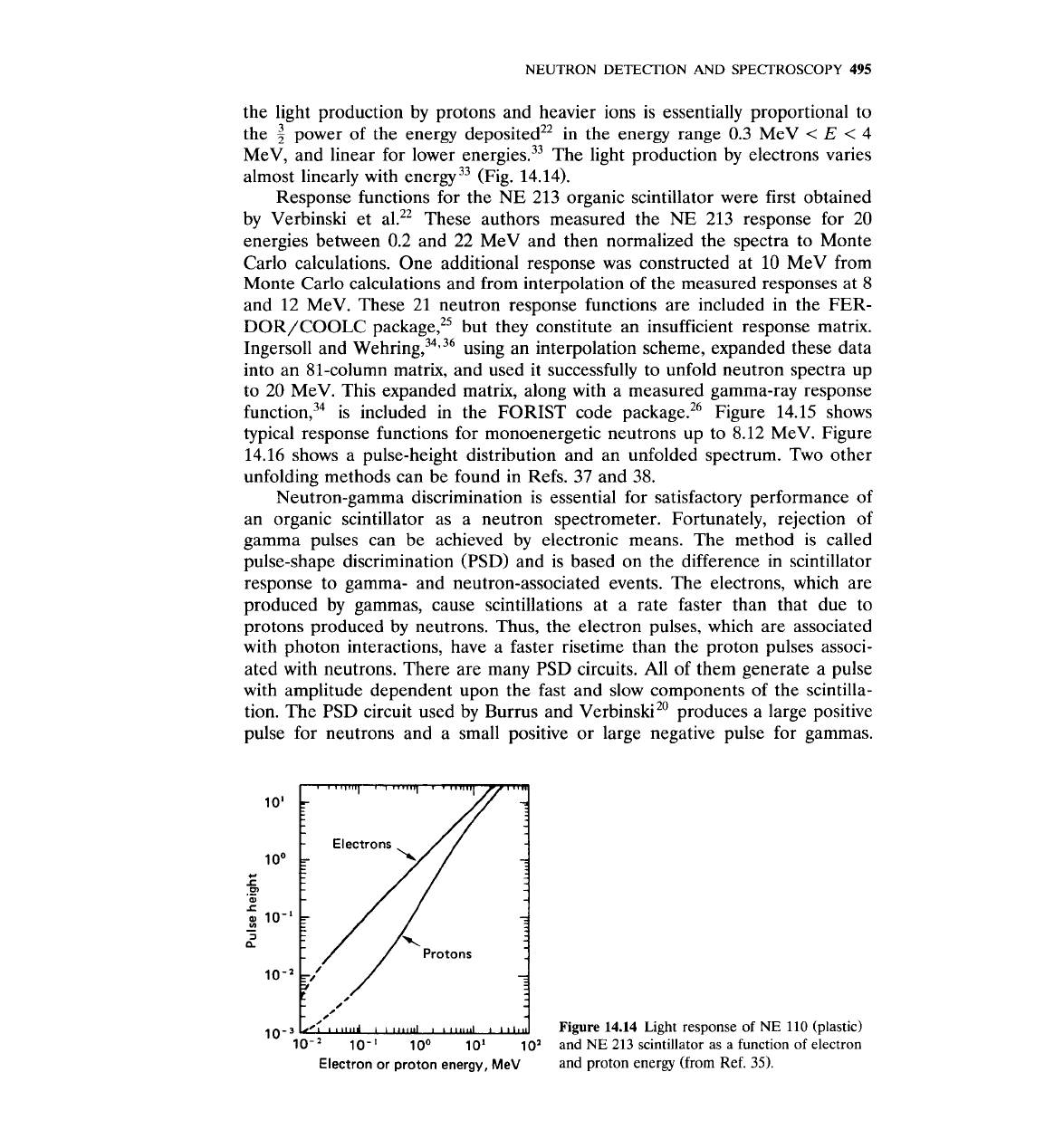
NEUTRON
DETECTION
AND
SPECTROSCOPY
495
the light production by protons and heavier ions is essentially proportional to
the
$
power of the energy deposited22 in the energy range
0.3
MeV
<
E
<
4
MeV, and linear for lower energies.33 The light production by electrons varies
almost linearly with energy33 (Fig. 14.14).
Response functions for the NE 213 organic scintillator were first obtained
by Verbinski et a1.22 These authors measured the
NE
213 response for 20
energies between 0.2 and 22 MeV and then normalized the spectra to Monte
Carlo calculations. One additional response was constructed at 10 MeV from
Monte Carlo calculations and from interpolation of the measured responses at
8
and 12 MeV. These 21 neutron response functions are included in the FER-
DOR/COOLC but they constitute an insufficient response matrix.
Ingersoll and
~ehrin~,~~,~~ using an interpolation scheme, expanded these data
into an 81-column matrix, and used it successfully to unfold neutron spectra up
to 20 MeV. This expanded matrix, along with a measured gamma-ray response
function,34 is included in the FORIST code package.26 Figure 14.15 shows
typical response functions for monoenergetic neutrons up to 8.12 MeV. Figure
14.16 shows a pulse-height distribution and an unfolded spectrum. Two other
unfolding methods can be found in Refs. 37 and
38.
Neutron-gamma discrimination is essential for satisfactory performance of
an organic scintillator as a neutron spectrometer. Fortunately, rejection of
gamma pulses can be achieved by electronic means. The method is called
pulse-shape discrimination (PSD) and is based on the difference in scintillator
response to gamma- and neutron-associated events. The electrons, which are
produced by gammas, cause scintillations at a rate faster than that due to
protons produced by neutrons. Thus, the electron pulses, which are associated
with photon interactions, have a faster risetime than the proton pulses associ-
ated with neutrons. There are many
PSD
circuits.
All
of them generate a pulse
with amplitude dependent upon the fast and slow components of the scintilla-
tion. The PSD circuit used by Burrus and verbinski20 produces a large positive
pulse for neutrons and a small positive or large negative pulse for gammas.
10'
r
-
Electrons
Figure
14.14
Light response of
NE 110
(plastic)
and
NE
213 scintillator as a function
of
electron
Electron or proton energy, MeV
and proton energy (from
Ref.
35).
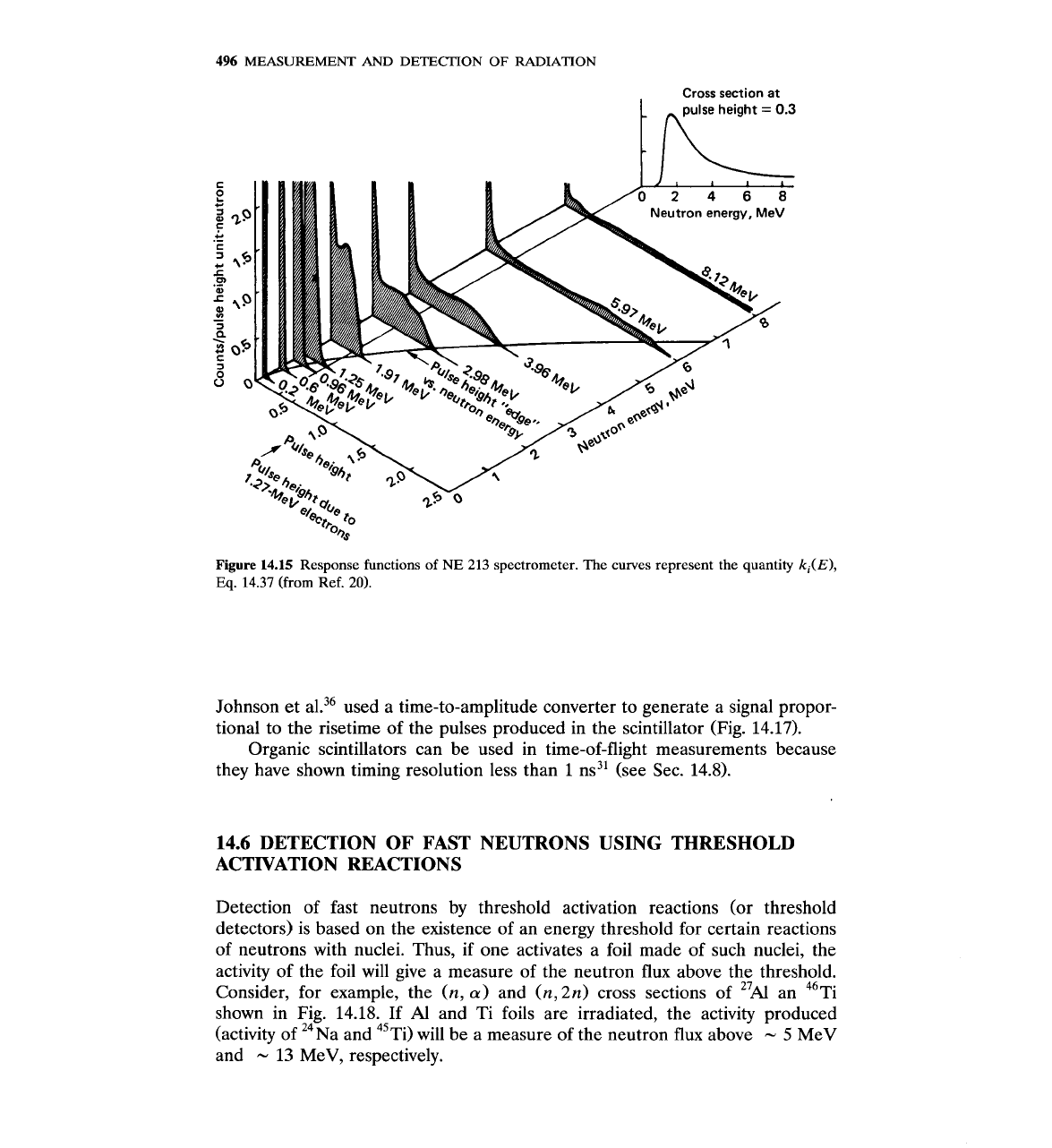
496
MEASUREMENT AND DETECTION
OF
RADIATION
Cross
section
at
Figure
14.15
Response functions of
NE
213 spectrometer. The curves represent
the
quantity
ki(E),
Eq.
14.37 (from Ref. 20).
Johnson et al.36 used a time-to-amplitude converter to generate a signal propor-
tional to the risetime of the pulses produced in the scintillator (Fig. 14.17).
Organic scintillators can be used in time-of-flight measurements because
they have shown timing resolution less than
1
ns3' (see Sec. 14.8).
14.6
DETECTION OF FAST NEUTRONS USING THRESHOLD
ACTIVATION REACTIONS
Detection of fast neutrons
by
threshold activation reactions (or threshold
detectors) is based on the existence of an energy threshold for certain reactions
of neutrons with nuclei. Thus, if one activates a foil made of such nuclei, the
activity of the foil will give a measure of the neutron
flux
above the threshold.
Consider, for example, the (n,
a)
and (n,2n) cross sections of
27Al
an
46~i
shown in Fig. 14.18. If
A1
and Ti foils are irradiated, the activity produced
(activity of 24~a and 45~i) will be a measure of the neutron
flux
above
-
5
MeV
and
-
13 MeV, respectively.
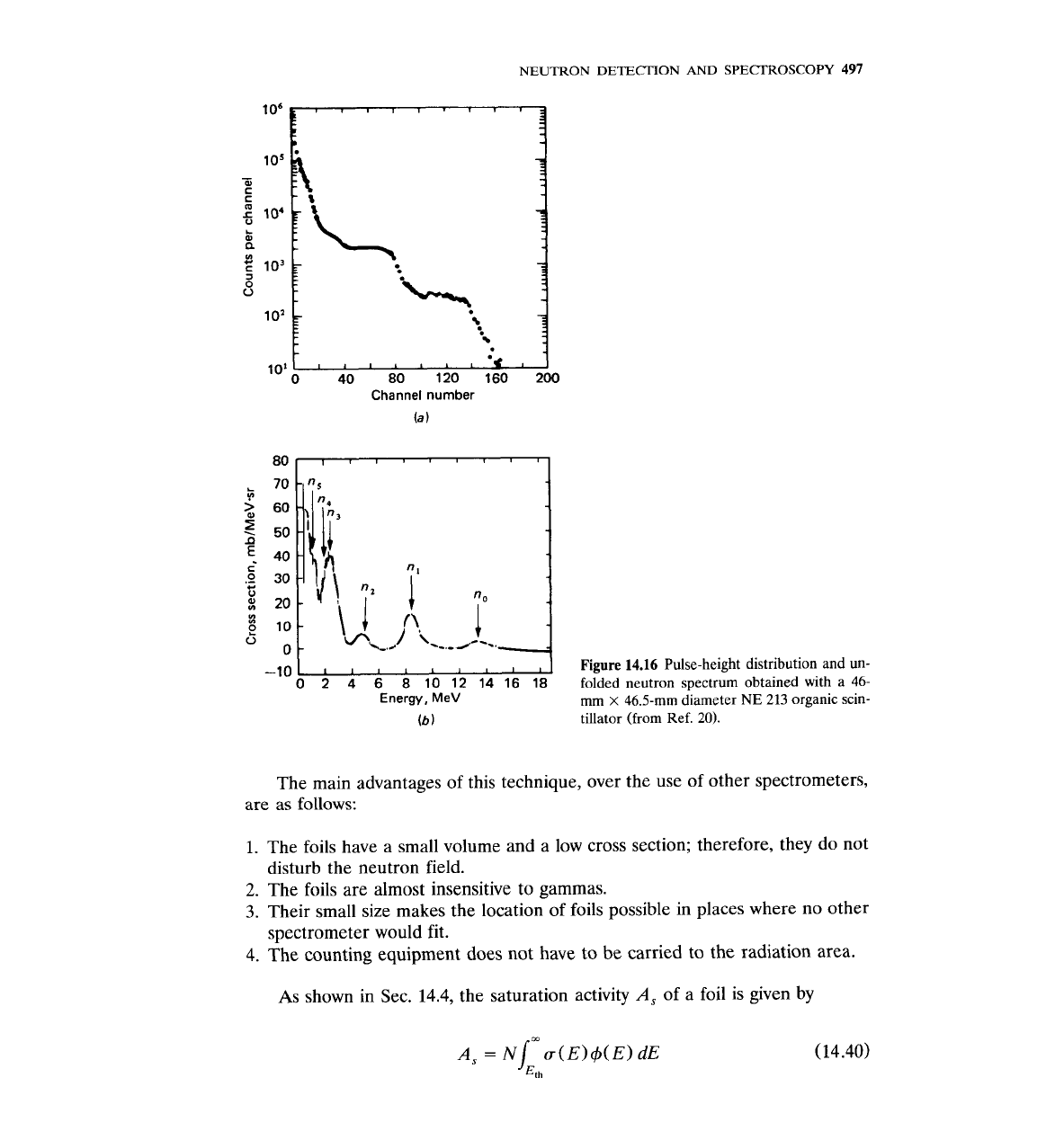
NEUTRON
DETECTION
AND
SPECTROSCOPY
497
Channel number
(a
-10
-
0
2
4
6
8 10 12 14 16 18
Energy, MeV
(b
Figure
14.16 Pulse-height distribution and un-
folded neutron spectrum obtained with a 46-
mm
X
46.5-mm diameter
NE
213
organic scin-
tillator (from Ref. 20).
The main advantages of this technique, over the use of other spectrometers,
are
as
follows:
1.
The foils have
a
small volume and
a
low cross section; therefore, they do not
disturb the neutron field.
2.
The foils are almost insensitive to gammas.
3.
Their small size makes the location of foils possible in places where no other
spectrometer would fit.
4.
The counting equipment does not have to be carried to the radiation area.
As shown in Sec.
14.4,
the saturation activity
A,
of a foil is given by
